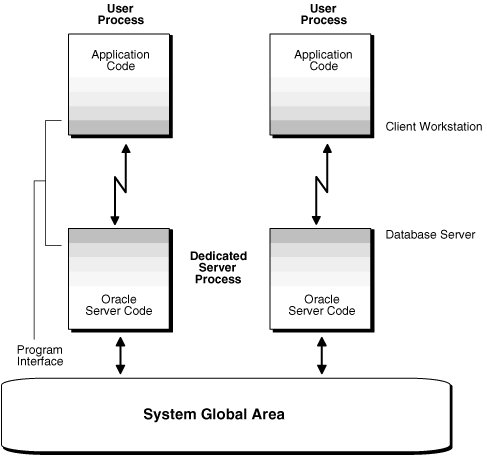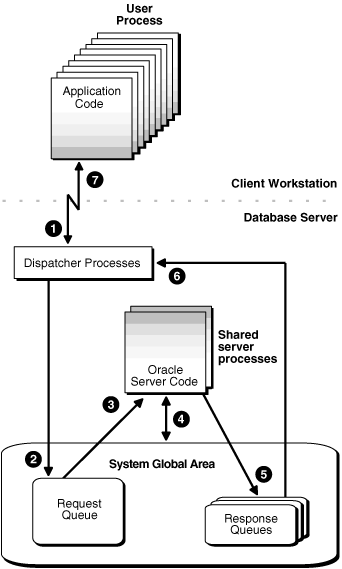| Oracle® Database Administrator's Guide 11g Release 1 (11.1) Part Number B28310-01 |
|
|
View PDF |
| Oracle® Database Administrator's Guide 11g Release 1 (11.1) Part Number B28310-01 |
|
|
View PDF |
Oracle Database creates server processes to handle the requests of user processes connected to an instance. A server process can be either of the following:
A dedicated server process, which services only one user process
A shared server process, which can service multiple user processes
Your database is always enabled to allow dedicated server processes, but you must specifically configure and enable shared server by setting one or more initialization parameters.
Figure 4-1, "Oracle Database Dedicated Server Processes" illustrates how dedicated server processes work. In this diagram two user processes are connected to the database through dedicated server processes.
In general, it is better to be connected through a dispatcher and use a shared server process. This is illustrated in Figure 4-2, "Oracle Database Shared Server Processes". A shared server process can be more efficient because it keeps the number of processes required for the running instance low.
In the following situations, however, users and administrators should explicitly connect to an instance using a dedicated server process:
To submit a batch job (for example, when a job can allow little or no idle time for the server process)
To use Recovery Manager (RMAN) to back up, restore, or recover a database
To request a dedicated server connection when Oracle Database is configured for shared server, users must connect using a net service name that is configured to use a dedicated server. Specifically, the net service name value should include the SERVER=DEDICATED clause in the connect descriptor.
See Also:
Oracle Database Net Services Administrator's Guide for more information about requesting a dedicated server connectionFigure 4-1 Oracle Database Dedicated Server Processes

Consider an order entry system with dedicated server processes. A customer phones the order desk and places an order, and the clerk taking the call enters the order into the database. For most of the transaction, the clerk is on the telephone talking to the customer. A server process is not needed during this time, so the server process dedicated to the clerk's user process remains idle. The system is slower for other clerks entering orders, because the idle server process is holding system resources.
Shared server architecture eliminates the need for a dedicated server process for each connection (see Figure 4-2).
Figure 4-2 Oracle Database Shared Server Processes

In a shared server configuration, client user processes connect to a dispatcher. The dispatcher can support multiple client connections concurrently. Each client connection is bound to a virtual circuit, which is a piece of shared memory used by the dispatcher for client database connection requests and replies. The dispatcher places a virtual circuit on a common queue when a request arrives.
An idle shared server process picks up the virtual circuit from the common queue, services the request, and relinquishes the virtual circuit before attempting to retrieve another virtual circuit from the common queue. This approach enables a small pool of server processes to serve a large number of clients. A significant advantage of shared server architecture over the dedicated server model is the reduction of system resources, enabling the support of an increased number of users.
For even better resource management, shared server can be configured for connection pooling. Connection pooling lets a dispatcher support more users by enabling the database server to time-out protocol connections and to use those connections to service an active session. Further, shared server can be configured for session multiplexing, which combines multiple sessions for transmission over a single network connection in order to conserve the operating system's resources.
Shared server architecture requires Oracle Net Services. User processes targeting the shared server must connect through Oracle Net Services, even if they are on the same machine as the Oracle Database instance.
See Also:
Oracle Database Net Services Administrator's Guide for more detailed information about shared server, including features such as connection pooling and session multiplexing